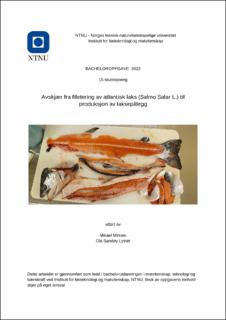| dc.contributor.advisor | Lerfall, Jørgen | |
| dc.contributor.author | Mirzaei, Mikael | |
| dc.contributor.author | Sandøy Lyster, Ola | |
| dc.date.accessioned | 2022-07-14T17:19:43Z | |
| dc.date.available | 2022-07-14T17:19:43Z | |
| dc.date.issued | 2022 | |
| dc.identifier | no.ntnu:inspera:110934805:111910763 | |
| dc.identifier.uri | https://hdl.handle.net/11250/3005536 | |
| dc.description.abstract | Ett av FN bærekraftsmål inkluderer å utrydde sult innen 2030. Dette har bidratt til interessen for forskningen og utviklingen av mer bærekraftig mat, som blant annet sjømat. Å kunne optimalisere utnyttelsen av næringsinnholdet fra Atlantisk laks (Salmo Salar L.) har tidligere blitt undersøkt, og flere studier har konkludert med at det er et stor potensiale å bruke avskjær fra laksefileten til ulike lakseprodukter. Dette har dannet grunnlaget til dette prosjektet, det målet er å øke kunnskapen om hvordan de forskjellige fraksjonene fra laksen kan brukes og utnyttes i laksepålegg.
Det ble til sammen produsert fem pålegg fra fem ulike fraksjoner henholdsvis filet, skrapekjøtt, buklist, nakkekjøtt og Bits & Pieces. Parametere som ble analysert var protein, fett, farge, tekstur og mikrobiell vekst. Koproduktene viste til varierende innhold av både fett og protein, som også resulterte til noen ulikheter i farge og tekstur. Eksempelvis hadde buklist et høyt fettinnhold og lavt proteininnhold, motsatt hadde skrapekjøtt et lavt fettinnhold og høyt proteininnhold. Dessuten gir høyt fettinnhold et mykere og mindre rødt produkt, mens høyt proteininnhold gir et fastere og rødere produkt. De mikrobiologiske analysene viste ikke til store forskjeller, og det ble konkludert med at koproduktene er minst like holdbar som laksepålegget laget med fileten. Videre arbeid må bli gjort, både sensorisk og kjemisk, for å kunne produsere et laksepålegg der smak, tekstur, farge og næringsinnhold er jevn slik at produktet blir akseptert av markedet. | |
| dc.description.abstract | Included in the UNs goals of sustainability, is the goal of zero hunger by 2030. This has contributed to an increase in research and development of more sustainable food, including seafood. Being able to optimize the yield of the nutrient content from Atlantic salmon (Salmo Salar L.) has previously been investigated, and several studies have concluded that there is a great potential to use the co-products from the salmon for various salmon products. Therefore, this project has a goal to increase the knowledge about how the different fractions from salmon can be used and utilized in salmon spreads.
A total of five orders were produced from five different fractions; fillet, deboned meat, belly flaps, neck meat and Bits & Pieces. Parameters analyzed were protein, fat, color, texture and microbial growth. The co-products content of both fat and protein varied, which also resulted in some differences in color and texture. For instance, the belly flap showed a high fat content and low protein content, on the contrary, deboned meat had a low fat content and high protein content. In addition, high fat content gives a softer and less red product, while high protein content gives a more firm and red product. The microbiological analyzes did not show any major differences, and it was concluded that the co-products and the salmon spread made with fillets, has the same shelf-life. Further work must be performed, both sensory and chemically, to be able to produce a salmon spread in which taste, texture, color and nutrient content are even so the product(s) is accepted by the market. | |
| dc.language | nob | |
| dc.publisher | NTNU | |
| dc.title | Avskjær fra filetering av atlantisk laks (Salmo Salar L.) til produksjon av laksepålegg | |
| dc.type | Bachelor thesis | |
